-
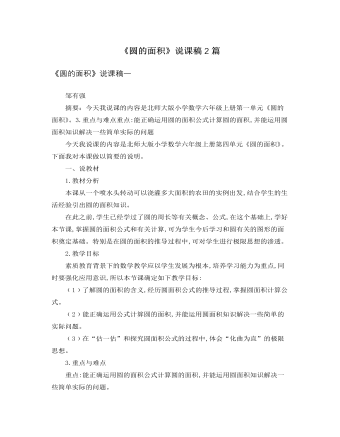
北师大版小学数学六年级上册《圆的面积》说课稿2篇
2.学法指导通过实例引入,引导学生关注身边的数学;在借助长方形面积公式来推导圆的面积公式的过程中,让学生通过观察、归纳、联想、转化等学习方法,动口、动手,动脑,培养学生学习的主动性和积极性。3.教学手段为了更好地展示数学的魅力,我结合多媒体辅助手段,充分地调动学生的感官,增加学习的形象感与趣味性,并且给学生留有足够的思考和交流的时间和空间,使学生成为课堂的主人。三、说教学过程1.创设问题情景,引入课题。出示课件让学生观察并说说从图中能发现什么数学信息,使学生在具体情境中了解圆面积的含义,体会到研究圆面积的必要性。2.探究思考,解决问题:估计圆的面积有多大。通过探究和思考使学生进一步体会到面积度量的含义,感受“化曲为直”的思想,同时培养学生的估计意识。
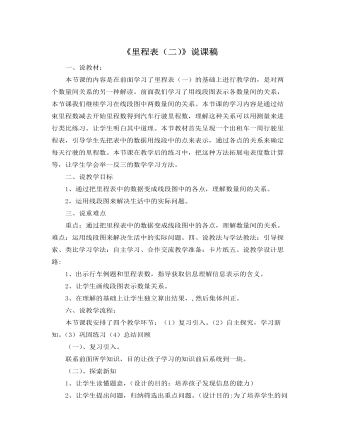
北师大版小学数学三年级上册《里程表(二)》说课稿
一、说教材:本节课的内容是在前面学习了里程表(一)的基础上进行教学的,是对两个数量间关系的另一种解读。前面我们学习了用线段图表示各数量间的关系,本节课我们继续学习在线段图中两数量间的关系。本节课的学习内容是通过结束里程数减去开始里程数得到汽车行驶里程数,理解这种关系可以用测量来进行类比练习。让学生明白其中道理。本节教材首先呈现一个出租车一周行驶里程表,引导学生先把表中的数据用线段中的点来表示,通过各点的关系来确定每天行驶的里程数。本节课在教学后的练习中,把这种方法拓展电表度数计算等,让学生学会举一反三的数学学习方法。二、说教学目标1、通过把里程表中的数据变成线段图中的各点,理解数量间的关系。2,运用线段图来解决生活中的实际问题。
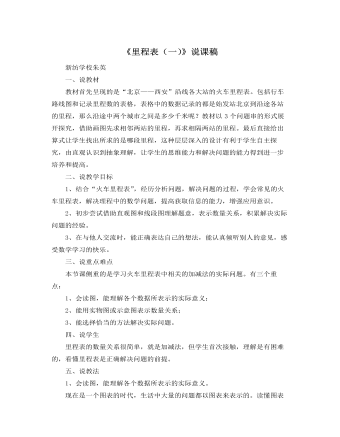
北师大版小学数学三年级上册《里程表(一)》说课稿
这是相隔两站的里程,相对问题1而言,难度有所增加。但数量关系不复杂,而此时学生已经有了问题1扎实的画图基础,所以我直接放手,让学生选择自己喜欢的方法画图,再算一算。3、会用图,能选择恰当的方法解决实际问题学习的最高境界是学以致用,画一画的目的是帮助自己解决问题,所以在学生初步掌握借助画图理解问题的基础上,我及时向学生提问,你还想求哪段,鼓励学生小组交流,并发现总结起点相同的里程问题的解决策略。在问题3时,我还是放手自主探究,因为有了前面的基础,此时,聪明的学生已经掌握了求两站之间的里程的方法,而接受能力稍微慢一点的学生通过画一画明确算式中相减的两个数量分别表示的哪一段路程,也能解答出来,这时再乘胜追击,鼓励学生说一个算式,让其他学生求的是哪两站之间的里程,这样的设计既巩固学习方法,又进行了开拓延展,可谓一举两得。本节课学生经历、感受着,借助画图分析问题、理解问题、解决问题的优越性。让学生在尝试、探索中发展了思维,提高了能力。
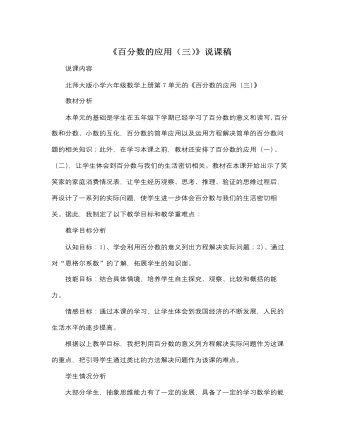
北师大版小学数学六年级上册《百分数的应用(三)》说课稿
三、巩固应用在这一环节,我设计了三个层次的习题,内容由浅入深,逐步提高,让学生体验到用数学知识解决实际问题的成功感,并给学生提供自主探索的时间和空间,从而产生积极的数学情感。第一个层次(基础练习):课件出示教材第28页中“试一试”的第一题,让学生根据情境中的信息,比较两题之间的异同,独立解答,然后交流解答方法,加深对百分数问题的理解。第二个层次(综合练习):课件出示教材第29页中“练一练”的第1、2、4题,鼓励学生独立分析题意,寻找等量关系,然后列方程解答。引导学生将题中的“二成”转化为百分数。第三个层次(提高练习):课件出示教材第29页中“练一练”的第5题,鼓励学生提出两个不同的问题并解答,培养学生根据统计图提供的信息提出问题的能力,使学有余力的学生有所提高。四、总结评价1、学生归纳总结在本节课你学到了什么,有哪些地方要提醒同学们注意。2、师作适当的补充和评价。此环节通过师生互动,生生互动,经历一次再学习,再巩固的过程。
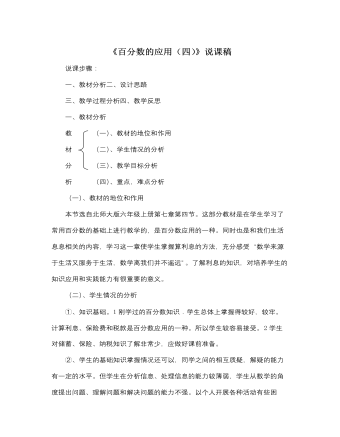
北师大版小学数学六年级上册《百分数的应用(四)》说课稿
1.注重创设情境,让学生从现实生活中学习数学。“良好的开端是成功的一半。”精彩的开篇不仅很快集中了学生的注意力,而且调动了学生主动参与学习的积极性。所以课的开始,我设计了王叔叔的例子.我的话语一落下,同学们就纷纷举起了手,发表自己的看法。首选的办法就是存银行,并且说出储存银行的好处。一是可以获得利息增值;二是可以支援国家建设。学生了解了储蓄的意义,从而引出课题,使他们感到要学习的内容与现实生活的紧密联系,有利于提高学习的兴趣.2、给学生充足的探索空间,让学生成为学习的主人。课堂上,让学生主动地进行数学学习,动手实践、自主探索、合作交流。3、积极引导学生把知识应用到生活中。数学来源于生活,也服务于生活,引导学生学会把课本中的所学,应用到日常生活中,学生对存款中的有关计算利息,本金、利率等知识了解的同时,也能结合学习中的体验开展实践交流活动,形成良好的消费观,也能把储蓄、纳税的知识应用到现实生活中来。
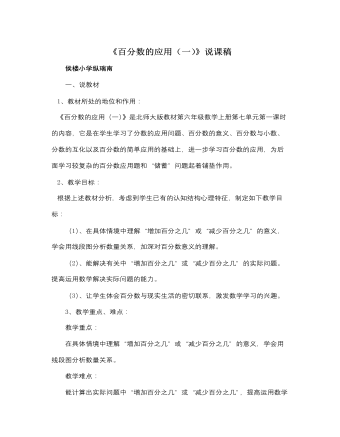
北师大版小学数学六年级上册《百分数的应用(一)》说课稿
在交流的过程中,教师要站在“导”的位置上,放手让学生说,最后总结出,解决这个问题,重点要理解问题的实质含义:究竟是谁和谁比,谁是单位“1”。本环节的设计既拓宽了解题思路,又锻炼了表达能力,同时也提高了抽象概括能力。(五)巩固拓展:实战演练,我最棒!在练习的设计上,我兼顾了习题的层次性和开放性,使不同层次的学生都参与练习,以求训练思维、培养能力、形成技能。(六)课堂总结通过学生说一说本节课自己的收获,达到对本节课知识点的梳理与整理,进一步巩固对知识点的掌握。总之,本节课教学活动我力求充分体现以下特点:以学生为主体,充分关注学生的自主探究与合作交流。教师是学生学习的组织者、引导者、合作者,对一个问题的解决不是要教师将现成的方法传授给学生,而是引导学生寻找解决问题的策略,给学生一把在知识的海洋中行舟的桨,让学生在积极思考,大胆尝试,主动探索中,获取成功并体验成功的喜悦。
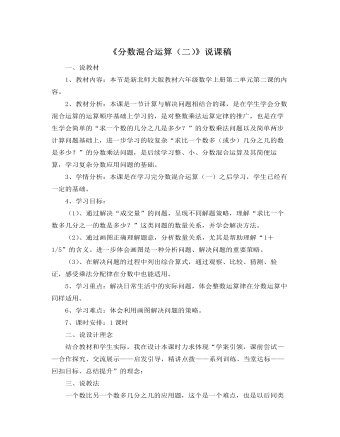
北师大版小学数学六年级上册《分数混合运算(二)》说课稿
一、说教材1、教材内容:本节是新北师大版教材六年级数学上册第二单元第二课的内容。2、教材分析:本课是一节计算与解决问题相结合的课,是在学生学会分数混合运算的运算顺序基础上学习的,是对整数乘法运算定律的推广,也是在学生学会简单的“求一个数的几分之几是多少?”的分数乘法问题以及简单两步计算问题基础上,进一步学习的较复杂“求比一个数多(或少)几分之几的数是多少?”的分数乘法问题,是后续学习整、小、分数混合运算及其简便运算,学习复杂分数应用问题的基础。3、学情分析:本课是在学习完分数混合运算(一)之后学习,学生已经有一定的基础。4、学习目标:(1)、通过解决“成交量”的问题,呈现不同解题策略,理解“求比一个数多几分之一的数是多少?”这类问题的数量关系,并学会解决方法。(2)、通过画图正确理解题意,分析数量关系,尤其是帮助理解“1+1/5”的含义。进一步体会画图是一种分析问题、解决问题的重要策略。
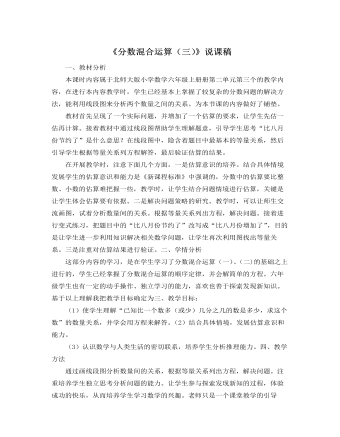
北师大版小学数学六年级上册《分数混合运算(三)》说课稿
教材首先呈现了一个实际问题,并增加了一个估算的要求,让学生先估一估再计算。接着教材中通过线段图帮助学生理解题意,引导学生思考“比八月份节约了”是什么意思?在线段图中,隐含着题目中最基本的等量关系,然后引导学生根据等量关系列方程解答,最后验证估算的结果。在开展教学时,注意下面几个方面。一是估算意识的培养。结合具体情境发展学生的估算意识和能力是《新课程标准》中强调的,分数中的估算要比整数、小数的估算难把握一些,教学时,让学生结合问题情境进行估算,关键是让学生体会估算要有依据。二是解决问题策略的研究。教学时,可以让师生交流画图,试着分析数量间的关系。根据等量关系列出方程,解决问题。接着进行变式练习,把题目中的“比八月份节约了”改写成“比八月份增加了”,目的是让学生进一步利用知识解决相关数学问题,让学生再次利用图找出等量关系。三是注重对估算结果进行验证。
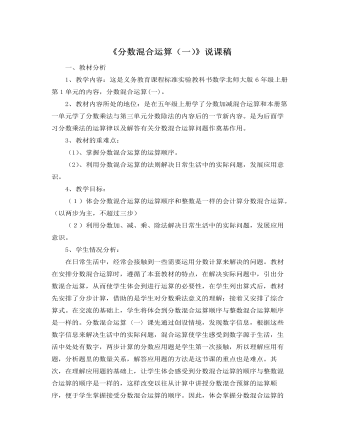
北师大版小学数学六年级上册《分数混合运算(一)》说课稿
二、教法根据教材呈现的内容,我在开展教学活动时是从以下几个方面思考。1、出示情境图,鼓励学生分析情境中的数学信息和数量关系,明确所要解决的问题,然后了解要解决这个问题需要什么样的条件,进而列出算式。2、讨论具体的计算方法。教材中呈现了两种计算方法。在这个过程中,教师可以先让学生自主进行计算,再组织讨论和交流算法之间的联系,明白分数混合运算的顺序。3、对问题的解决加以解释,即航模小组有3人。三、学法通过本节教学,学生学会运用直观的教学手段理解掌握新知识,学会有顺序的观察题、认真审题、正确计算、概括总结、检查的学习习惯。四、教学程序(一)谈话设计意图:激发学生兴趣,调动学生学习的积极性。(二)复习旧知1、复习整数混合运算的顺序。

人教版高中英语必修2Cultural Relics说课稿2篇
Ⅲ. Analysis of the teaching material:The topic of this unit is cultural relics. Students are quite interested in topics about different cultures around the world. This is the second period of the whole unit. As a reading class, the passage mainly talks about the history of the amber room (how it was made, sent as a gift, lost and rebuilt).According to the new national curriculum, when teaching reading, much emphasis should be put on training the students’ reading skills.Ⅳ. Teaching objectives1. Language objectives:1) Students are required to master the key words and phrases occurred in the passage (e.g. amazing, decorate, belong, in return, less than etc.)2) Students are required to learn the attributive clause and acquire the sentence pattern.2. 1) Students are required to describe a certain thing by using the new sentence patterns.2) Students are required to master two kinds of reading skills—skimming and scanning, and learn to use them in their daily reading.3. 1) Students are required to know the history of the amber room.2) Students are required to appreciate cultural relics and understand the importance of protecting them.Ⅴ. Teaching important and difficult points1) the new words, phrases, and sentence pattern in the course of reading.2) Teaching difficult point: Help the students master two kinds of reading skills—skimmingand scanning and learn to apply them in daily use.Ⅵ. Teaching methods:Task-based method & Top-down model Ⅶ. Teaching aids: PPT, pictures, blackboard Ⅷ. Teaching procedure:

人教版高中英语必修2Wildlife Protection说课稿3篇
When it comes to the students’ studying methods, I'd like to introduce my Ss first. The Ss have a good command of basic language points. They’re interested in learning English, and they take an active part in English class, so they will have fun in autonomous, cooperative and inquiry learning. I will just serve as a guide, showing them the way to explore how to make more progress in their English learning.Now it’s time for the most important stage of this lesson. My teaching procedures are arranged as follows:Step1.Leading-in (3 minute)Play a video of a wide variety of wildlife to introduce my topic. Step2. Speaking (12 minutes)We will use our textbook Page25. Let the Ss fast read the short paragraph to warm up. Ask them to talk about the report on some endangered wildlife in China with the dialogue patterns on the screen. Lastly, I will invite some groups to demonstrate their dialogues about saving wildlife in China.Step3.English play (3 minutes)Watch another video in praise of their excellent performance just now. It’s about Jack Chen’s(成龙)and Yang Ziqiong’s wildlife protection.Step4. Listening (twice 13 minutes)This time, I’ll ask the Ss to fill in the blanks of the monologue of the 2 movie stars above. Step5.Discussion (3 minutes)Which would you like to choose to wear, clothes made of cotton, artificial leather or animal skins? Why ?Step6. Summary (3 minutes)1. If there were no wildlife, there wouldn’t exist human beings. If the buying stops, the killing can, too.2. Animals are our friends. To love animals is to love ourselves. Stop hunting, killing and destroying wildlife.3. Let’s live in harmony with all the living things in the world. Step7. Music appreciation (3 minutes)Let the Ss appreciate the song Earth Song by Michael Jackson. Last but not the least, I will show you my blackboard design.

人教版高中英语必修4Women of achievement说课稿4篇
Good morning, distinguished judges:It’s my honor to talk about my teaching ideas with you. Today my topic is Women of Achievement. My presentation consists of six parts: the analysis of teaching material and student, teaching aims, key and difficult points, teaching and studying method, teaching procedures and blackboard design.First, let’s focus on the analysis of teaching material. This lesson is from New Senior English for China Student’s Book 4 Unit 1, the reading part. The main topic of the passage is the introduction of a student of Africanwildlife. After this lesson, the students will learn more information about her studying chimps in Africa, and their reading and speaking abilities can be developed as well.The next part is the analysis of students. My students are in senior high students. They have learnt English for many years, they’ve known many words and sentences, but their speaking and reading abilities are still not very good. So I will practice their speaking and reading abilities through different exercises.According to the New Standard Curriculum and the present situation, I set the teaching aims as follows: firstly, knowledge aims. Students can grasp some new words, such as worthwhile, move off. Moreover, students can understand the content of the passage and get familiar with the topic of studying chimps in wildlife. Secondly, ability aims. Students can use reading strategies such as skimming and scanning in reading process. Thirdly, emotional aims. Students can have the awareness of protecting animals and care about animals.Based on the above analysis, the key point of this lesson is to get the main idea and the detailed information from the passage; the difficult point is to talk about the wildlife protection and use reading strategies.

人教版高中英语必修3Healthy Eating说课稿4篇
Language learning needs a context, which can help the learners to understand the language and then can product comprehensible output, so computer has the advantages to make the materials attractive.Part 3 Learning MethodsTask-based, self-dependent and cooperative learningPart 4 Teaching ProcedureStep One Lead-in“Interest is the best teacher.” Therefore, at the very beginning of the class, I should spark the students’ mind to focus on the centre topic “the band”. I’ll show some pictures of food to attract their attention and then bring some questions.Question:What kind of food they like?What should go into a good meal?The answers must relate to the diet. After this, the students will be eager to know something about a balance diet and this is the very time to naturally lead the class into Step 2Step 2 Reading for information: skimming and scanning In this step, I use Task-based Language Teaching method, which can give students a clear and specific purpose while skimming and scanning the context.Task 1 General ideaThe students will be asked to just glance at the title and the pictures of the passage, and then guess what they will read in the text. And they’ll be divided into groups of four to have a discussion.The purpose is to inspire the students to read actively, not passively. In addition, the task is to develop the students’ reading skill by making prediction and to encourage the students to express their thoughts in English and cooperate with each other.Task 2 Main idea of each paragraphCooperative learning can raise the students’ interest and create an atmosphere of achievement. Based on this theory, I divide the whole class into 4 groups to skim the whole text and get the main idea of each paragraph.

人教版高中英语必修5First aid说课稿6篇
In this class, I have 3 teaching aims, that is, knowledge aims, ability aims and emotion aims.1) Knowledge-Teach students new words and expressions, such as temporary, bleed,sprain choke, first aid, fall ill and so on.-Enable students to have a better understanding for some basic knowledge of first aid.2) Ability-Train students’ speaking, reading and writing abilities by different teaching activities, such as skimming, comprehending, team work, role play, retelling and writing.-Develop students’ reading strategy on how to move general idea to specific information.3) Emotion-Promote students’ awareness of giving first aid.- Cultivate students’ creativities.Then let’s come to my teaching methods and activities.III. Teaching methods and activities:To achieve different teaching aims, various kinds of teaching methods and activities will be adopted throughout this period, such as TBL (task-based learning), skimming, team work, brainstorm and others, which can offer students opportunities to fulfill tasks in which they can use language to achieve a specific outcome.IV. Teaching aids:Computer and blackboardV. Teaching important points:1) Make students have a clear mind for the structure of the text.2) Help students understand the theme of the text.VI. Teaching difficulties:1) So many new words may affect students’ understanding.2) How to get students to know about the functions of the skin and thecauses, characteristics and treatments for different degree burns,and the knowledge about giving first aid. VII. Blackboard design:

人教版高中英语必修5Making the news说课稿4篇
今天我们来介绍一下必修五第四单元的授课方式。这个单元的题目是Making the news。应该是学生比较感兴趣的话题,学生往往对新闻工作充满好奇,所以我们可以利用这个机会多设计一些师生互动和学生互动,来激发起学习的积极性,提高学习效率。同时我们可以利用这个单元不仅帮助学生掌握语言知识,培养语言能力,同时让其了解新闻工作的重要性,培养起社会智能感。这个单元分为六个课时,它的教学目标是这样的:语言目标是掌握词汇表中的常用单词和短语,掌握倒装句的一些基本用法。 技能目标是能初步掌握约会的基本句型并在真实的场景下正确运用。新闻报道类文章的写作技能。采访的基本规范和沟通技能。情感目标是对新闻报道的客观性和真实性有更好的理解。对新闻记者的职业有更深入的了解,并能体会其工作的重要性。下面我们来介绍一下第一课时的授课方式,第一课的教学目标是这样的第一课时的教学目标语言目标:单词:Occupation, journalist, editor, photographer, curious, personality, enthusiasm

人教版高中英语必修4Body Language说课稿4篇
Textbook: Senior English for China (Book 4), by Liu Daoyi Time Allotment: 1 period (40 minutes)Date: March 20, 2014Teaching aids: blackboard, Multi-media, Power Point, chalk I. Text Analysis (教材分析)This unit is about body language, and the text selected in the reading part demonstrates the difference and similarity of body language in many parts of the world. Through learning this passage, students are required to raise their awareness of using body language in different parts of the world. As body language is closely related to our daily life, it is easy to arouse students’ interest in learning this text. Reading skills and speaking training are designed around the text.II. Teaching Objectives (教学目标)By the end of the lesson, students will be able to:1. Language Skill Objective(语言技能目标): develop reading ability (skimming and scanning)as well as speaking ability.2. Cultural Knowledge Objective(文化知识目标): know about the cultural differences of using body language.3. Affective Objective(情感目标): increase students’ awareness of using body language correctly in different cultures. III.Teaching Focuses and Difficulties(教学重点和难点)1. Teaching Focuses(教学重点): the difference and similarity of body language in many parts of the world.2. Teaching Difficulties(教学难点): develop students’ reading abilities of skimming and scanning and ask the students to show their opinions with fluent English.

人教版高中英语必修2Computers说课稿3篇
一. 教材分析1. 本单元的中心话题是“计算机(Computers)”,内容涉及计算机的发展历史,计算机的应用等。本节课是该单元的第一课时,我将Warming up, Pre-reading and Comprehending这四部分整合为一节精读课。其中。Reading部分是题为WHO AM I?的文章,以第一人称的拟人手法介绍了计算机发长演变的历史和计算机在各个领域的应用,其主旨是表达计算机的发展变化之快以及在生活中用途之广。而Warming up部分以图片的形式展现了计算机的发展历程;Pre-reading中的问题和排序分别是为了预测语篇的内容和测试学生对计算机历史了解的情况;Comprehending则通过各项练习训练学生的阅读技能,从而加深对文章的理解。可见这几部分是一个有机的整体。2. 教学目标:1) 语言目标:重点词汇及短语:abacus, calculate, calculator, PC, laptop, PDA, robot, analytical, technological, universal, mathematical, artificial, intelligent, network, explore, in common, as a result.重点句子:a. My real father was Alan Turing, who in 1963 wrote a book to describe how computers could be made to work, and build a “universal machine” to solve any mathematical problem.

人教版高中英语必修2The Olympic Games说课稿2篇
Purpose of my design:To ask the students to do these two tasks will make the Ss predict the story of this passage. As a result, it will deepen Ss’ memory of this story because they will have their own understanding of this story.Step 3. While-readingTask 1. (Individual work _____min)Skimming: ask students to skim the text and the main ideas of each paragraph in this passage. Please read it quickly and then match the sentences with the letters.Task 2. (Individual work _____min)Scanning: read the text quickly and decide the whether the following statements are true or false and give reasons.Task 3. (Pair work _____min)Listen to the tape and fill in the banks. Then read the paragraph with expression to your partner.Task4 (individual work min)Listen to the tape again and write down the main idea in one sentence.Purpose of my design: Enable students to understand the given material better by using different reading skills. And proper competition can arouse the Ss’ interest in English learning. “Task-based” teaching method is used here todevelop the Ss’ ability of communication and also their ability of co-operation will be well trainedStep 4. Post-readingTask 1. (Individual work, pair work, group work, class work; _____min)Discussion (group of 4):1. If you were Hippomenes, would you run against Atlanta?2. Do you think Hippomenes deserved to win the race? Why or why not?Step 5. HomeworkPlease read the story again carefully after class and imagine: What will happen during the race between Hippomenes and Atlanta? Who do you think will win the race? Do you think Atlanta would marry Hippomenes? Write an end for the story with thses questions.Purpose of my design: Homework is so important and necessary for to master the knowledge they learned after class. It will check whether the Ss achieve the teaching aims.Part 5 Blackboard design

人教版高中英语必修3Astronomy the science of the stars说课稿3篇
Step 2 Pre-listeningAfter students finish their discussion, I will show a picture of Newton and ask them: Who is him? What is he famous for? Could you find out some words to describe him? Maybe students will answer that he is genius for his finding of theGravitation, making a great contribution to the progress of human being. At that time I will show another two pictures of Einstein and Hawking, letting students guess who they are and write down their idea about the Gravitation. For I have arranged them to search more information about the gravity before this class, Students have beenfamiliar with the topic and will not be afraid about this abstract conception, which is helpful for their listening.Step 3 While-listeningIn this step, students will be required to listen the material for three times. The first and listening is extensive listening and the second and third listening is intensive listening. In the first time, They are required to listen a material including Part 1 and Part 2 and choose the best summary of the listening text. After they choose the right answer, They also need work in group to explain what is wrong with the others. Then I will make a conclusion that we should pay attention to the first paragraph and last paragraph and some keys to get the main idea. By doing this, their capacity of generalization will have a great improvement.Before the second listening, I will ask students to scan the blank on the power point quickly and ask them to note down some key words .Then ask them to listen to the Part 1again and fill the first column of the chart. Maybe some students just show the ideas of these three scientists an still can’t catch their development of gravity. Therefore, I will ask them to listen to Part 2 again and fill in the rest. After finish the listening, I will give them ten minutes to discuss with their partner. I will also guidethem to improve their answers when they discuss with others.

人教版高中英语必修4A taste of English Humor说课稿3篇
Then I would ask them to think of a funny English or Chinese and tell it to partners. While telling stories, they can use expressions and some acting to help make the story funny. 5 minutes would be given to do this.Those stories they told there will be the material for their writing. Soletting them tell it at first is helpful. And they can make a difference between telling a funny story and writing it down. Generally speaking, it is difficult forstudents to write well because they don’t know what to write and how to write. Asking them to tell their own stories at first can help them come up with what to write.After their telling, I would invite someone to share his/her story with all of us and I would write it down on the blackboard.This example story would be used as a sample to illustrate the format of funny story. Different from a story from teacher or textbook, a story from students can obviously become a interesting material to draw students’ attention.Then I would ask the whole class to put this story into several parts. It might be a little bit difficult for them. So I would ask them to find out whether all the sentences are necessary. After delete some sentences, there are 6 sentences left behind. Then they can easily put them into three parts. After interaction with students, I would teach them the right terms for each part and conclude the format of funny story.This step is the key and difficult point in my lesson. So I mainly usetask-based teaching method in this part and the task for students was divided into several stages. With the separated difficult level, students can find there are usually three parts in writing. They can also learn to write without the unnecessary parts in the process of analyzing. And then I wouldn’t rush to tell them the right terms to them directly. Instead, I would ask them to name them by their own. A confused mind is better for acquiring knowledge.While-writing:Then I would give students 7 minutes to write down this story, without other requirements.With all the preparations in pre-writing, students’ difficulties were cleared. So it would be much easier for them to write down the story within 7 minutes. There are no other requirements because students’ first writing is actually a drafting. It would be revise and edit several times later. Writing, as a skill

